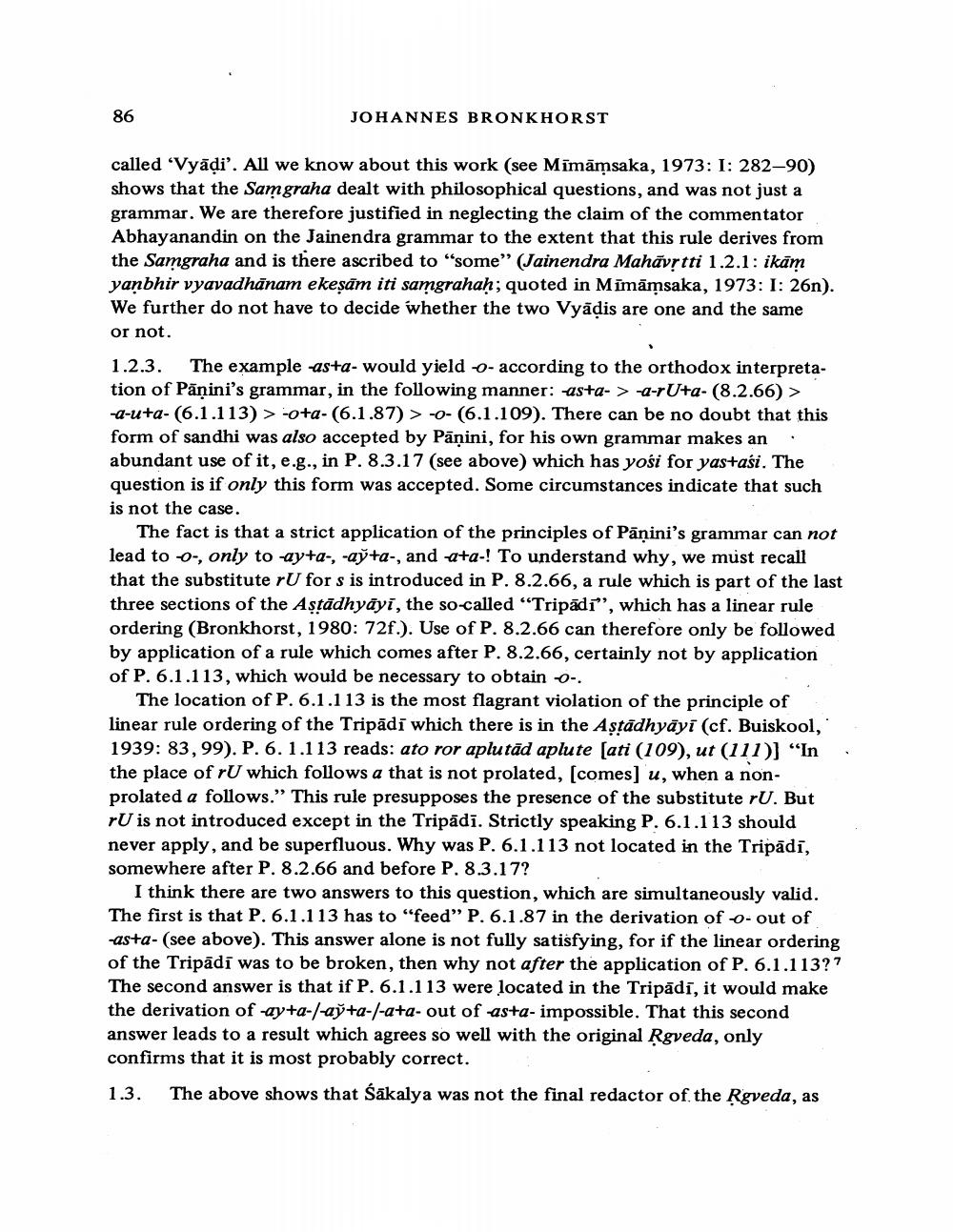________________
86
JOHANNES BRONKHORST
called 'Vyādi'. All we know about this work (see Mīmāmsaka, 1973: 1: 282-90) shows that the Samgraha dealt with philosophical questions, and was not just a grammar. We are therefore justified in neglecting the claim of the commentator Abhayanandin on the Jainendra grammar to the extent that this rule derives from the Samgraha and is there ascribed to "some" (Jainendra Mahāvștti 1.2.1: ikām yanbhir vyavadhānam ekeșām iti samgrahaḥ; quoted in Mīmāmsaka, 1973: 1: 26n). We further do not have to decide whether the two Vyādis are one and the same or not. 1.2.3. The example asta- would yield o- according to the orthodox interpretation of Pāņini's grammar, in the following manner: asta- > -a-rU+a- (8.2.66) > -a-u+a- (6.1.113) > -ota-(6.1.87) > -o- (6.1.109). There can be no doubt that this form of sandhi was also accepted by Pāņini, for his own grammar makes an . abundant use of it, e.g., in P. 8.3.17 (see above) which has yośi for yastasi. The question is if only this form was accepted. Some circumstances indicate that such is not the case.
The fact is that a strict application of the principles of Pāṇini's grammar can not lead to o-, only to -ay+a-, -aỹta-, and a+a-! To understand why, we must recall that the substitute rU for s is introduced in P. 8.2.66, a rule which is part of the last three sections of the Astādhyāyi, the so-called “Tripādi", which has a linear rule ordering (Bronkhorst, 1980: 72f.). Use of P. 8.2.66 can therefore only be followed by application of a rule which comes after P. 8.2.66, certainly not by application of P. 6.1.113, which would be necessary to obtain o-.
The location of P. 6.1.113 is the most flagrant violation of the principle of linear rule ordering of the Tripādi which there is in the Astādhyāyi (cf. Buiskool, 1939: 83,99). P. 6.1.113 reads: ato ror aplutād aplute (ati (109), ut (111)] "In the place of rU which follows a that is not prolated, (comes] u, when a nonprolated a follows." This rule presupposes the presence of the substitute rU. But rU is not introduced except in the Tripādī. Strictly speaking P. 6.1.113 should never apply, and be superfluous. Why was P. 6.1.113 not located in the Tripādi, somewhere after P. 8.2.66 and before P. 8.3.17?
I think there are two answers to this question, which are simultaneously valid. The first is that P. 6.1.113 has to "feed" P. 6.1.87 in the derivation of o- out of asta- (see above). This answer alone is not fully satisfying, for if the linear ordering of the Tripādi was to be broken, then why not after the application of P. 6.1.113?? The second answer is that if P. 6.1.113 were located in the Tripādi, it would make the derivation of ay+a-/-ay+a-/-a+a- out of asta-impossible. That this second answer leads to a result which agrees so well with the original Rgveda, only confirms that it is most probably correct. 1.3. The above shows that Śākalya was not the final redactor of the Rgveda, as




